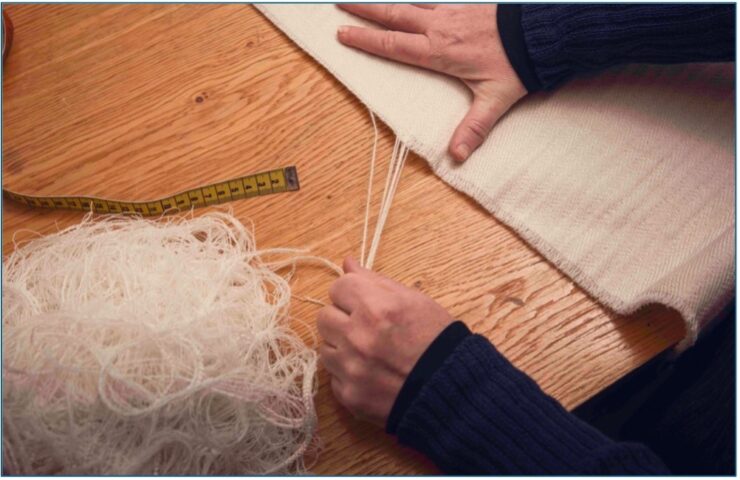Documentation
“The Dramaturgy of Enquiry: Weaving Care, Art, and Knowledge” – Yente van Hulst

Birgitta Nordström (https://birgittanordstrom.se/phd-projects)
On December 13, 2023, I attended the workshop “How to Know Things with Works: On Practical Enquiry” as part of Transmission in Motion’s seminar series “Matters of Concern” at Utrecht University. The event featured Mick Wilson, a distinguished professor of art and director of doctoral studies at HDK – Valand Academy of Art and Design (University of Gothenburg). Wilson’s expertise in contemporary social and political imaginaries guided our exploration of research methodologies, particularly those that involve doing, making, and showing.
Wilson encouraged us to reconsider the conventional boundaries between epistemology and ontology, urging us to integrate practical enquiry into research methods. How should research be conducted? Is there a singular path to knowledge, or should we consider practical enquiry as a parallel, equally valid approach? As Wilson asked us these questions, a surge of other questions filled my mind. What does it mean to truly ‘know’ something? How does the act of creating and making contribute to knowing? These questions lingered as we transitioned into smaller groups, in which I encountered Birgitta Nordström’s project, I Sin Linda/Infant Shrouds. Nordström is currently a doctoral candidate in Craft at the University of Gothenburg. Her Ph.D. project centered around I Sin Linda/Infant Shroud in which she researched woven textiles used for funerals and perinatal loss. In this artistic exploration, Nordström went beyond traditional research boundaries and transcended the realm of academia.
In front of me lay one of Nordström’s woven blankets, a tangible artifact of her practice of mortuary care for perinatal loss. The material was soft, with some loose treads still visible. The blankets were thicker and heavier than I expected, although very small. The multiple blankets throughout the room all slightly differed, like every blanket was made specifically with a child in mind. It was then that the questions I had been grappling with took on a new dimension. What kind of questions had Nordström been asking herself during the making process of these blankets? How did the ecology of materials play a role in her creative decisions? More profoundly, how did the time and care invested in each blanket became an integral part of the mourning process for families facing child loss?
Nordström’s project became a lens through which I contemplated the intricate balance between art, research, and care. The seminar emphasized that the act of enquiry begins in the practical world, prompting me to reflect on my own research. Is epistemology truly the best starting point for every enquiry, or should I consider the merits of practical enquiry from the outset more?
The weaving of the smallest wrapping cloths for children who never had a chance to live became a poignant metaphor for the interconnectedness of knowledge and empathy. As we explored the relations, modes of care, and agency of practices and materials within Nordström’s process, it became clear this was not just an art project, but a form of compassionate enquiry that transcended the academic realm.
This kind of enquiry is very relevant in the field of dramaturgy, where the synthesis of practice and science is paramount. A dramaturg needs to navigate the balance between artistic creation and scholarly enquiry, employing practical enquiry to unravel the complexities inherent in theatrical productions. The ability to pose meaningful questions, much like those inspired by Nordström’s project, allows a dramaturg to delve into the emotional and intellectual dimensions of a performance, contributing to a more profound understanding of human experiences within a dramatic context.
The seminar underscored the entanglement of science and everyday life, challenging me to expand my understanding of how (theatre) scholars can contribute to matters of concern. It urged me to consider ‘unconventional’ ways of acquiring knowledge and prompted a deeper reflection on the inherent human desire to know. This exploration of Nordström’s has sparked my curiosity about the role of practical enquiry in my own research and an appreciation for the impact art has on matters of deep human concern. As I continue on my path of becoming a dramaturg, I carry with me not just the knowledge imparted by Mick Wilson and the insights gained from Nordström’s project, but a renewed sense of purpose in weaving care into my academic pursuits.
References
- Candy, Linda, and Edmonds, Ernest A. “Practice-Based Research in the Creative Arts: Foundations and Futures from the Front Line” Leonardo 51/1 (2018): 63-69.
- Carltoft, Maja. “Birgitta Nordström wants to offer textiles that comfort during the worst of all tragedies.” HDK-Valand – Acadmy of Art and Design (2023). https://www.gu.se/en/research/birgitta-nordstrom-wants-to-offer-textiles-that-comfort-during-the-worst-of-all-tragedies.
- Nordström, Birgitta. “I sin linda 2017-19 [Making Narratives; 4].” HDK-Valand – Academy of Art and Design (2019). https://issuu.com/universityofgothenburg/docs/making-narratives-4.
- Nordström, Birgitta, and Groth, Camilla. “The Role of the Weaver in the Encounter with Life and Death.” In Craft Sciences, edited by Tina Westerlund, Camilla Groth and Gunnar Almevik. 291-314. Gothenburg: Acta Universitatis Gothenburgensis, 2022.
- Wallace, James D. “Practical Inquiry.” The Philosophical Review 78/4 (1969): 435-450.

